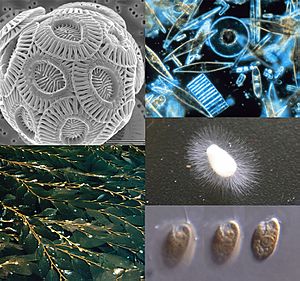Chromalveolate facts for kids
Quick facts for kids Chromalveolates |
|
|---|---|
 |
|
| Clockwise from top-left: a haptophyte, some diatoms, an oomycete, a cryptomonad, and Macrocystis, a phaeophyte | |
| Scientific classification | |
| Domain: | |
| (unranked): | |
| Kingdom: |
Chromalveolata
Cavalier-Smith 1998
|
| Phyla | |
Chromalveolata is a large group of living things. Most of them are tiny, single-celled organisms. But some, like kelp, can grow very big! Scientists first thought this group was a "supergroup" of eukaryotes. Eukaryotes are living things whose cells have a special control center called a nucleus.
The idea of Chromalveolata was first suggested by a scientist named Thomas Cavalier-Smith. He proposed it in 1998. It was an updated idea from his earlier "Kingdom Chromista" from 1981.
Contents
What are Chromalveolates?
Chromalveolates include many different types of organisms. Some are algae, which are like plants but simpler. Others are protozoa, which are tiny animal-like creatures. This group is very diverse.
For example, it includes:
- Brown algae: These are large seaweeds like kelp. They live in the ocean.
- Diatoms: These are tiny, single-celled algae. They have beautiful glass-like shells.
- Dinoflagellates: These are also tiny, single-celled organisms. Many of them can glow in the dark!
- Ciliates: These are protozoa that have tiny hair-like structures called cilia. They use cilia to move and eat.
How Did Chromalveolates Get Their Start?
Scientists believe Chromalveolates have a very interesting origin story. It's like a story of one cell "eating" another! This process is called endosymbiosis.
The Red Alga Connection
The main idea is that a very old cell, called a bikont, took in a red alga. A bikont is a cell that has two whip-like tails called flagella. These tails help it move around.
When the bikont took in the red alga, it didn't digest it. Instead, the red alga started living inside the bikont. Over a long time, the red alga changed. It became a special part of the bikont cell, called a plastid. Plastids are like tiny factories inside cells that make food using sunlight.
Chlorophyll c
These new plastids had a special green pigment called chlorophyll c. Chlorophyll is what makes plants green and helps them capture sunlight for energy. This special chlorophyll c is a key feature of many Chromalveolates.
Why is Their Classification Challenged?
Even though the idea of Chromalveolata was popular, some scientists have questioned it. They found new information about how these organisms are related.
New Discoveries
With new tools and research, scientists can now look at the DNA of different organisms. This helps them understand how living things are related to each other. Sometimes, new DNA evidence shows that groups once thought to be together are actually not.
So, while Chromalveolata was an important idea, the way scientists classify these organisms is always changing. It's like a puzzle that scientists are still trying to solve!
Images for kids
-
A potato plant infected with Phytophthora infestans
See also
 In Spanish: Chromalveolata para niños
In Spanish: Chromalveolata para niños



